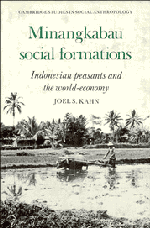Book contents
- Frontmatter
- Contents
- Lists of maps, figures and tables
- Preface
- Map
- 1 Introduction
- 2 The internal and the external in a Minangkabau village: an introduction to the world of the concrete
- 3 Adat, kinship and marriage: the constitution of the subsistence community
- 4 Agriculture and subsistence: the reproduction of the subsistence community
- 5 Commodity production in the village economy: the case of blacksmithing
- 6 Occupation, class and the peasant economy
- 7 The structure of petty commodity production
- 8 Mercantilism and the evolution of ‘traditional’ society
- 9 The emergence of petty commodity production
- 10 Conclusions: The concept of a neo-colonial social formation
- Bibliography
- Glossary of Minangkabau terms
- Index
- CAMBRIDGE STUDIES IN SOCIAL ANTHROPOLOGY
Preface
Published online by Cambridge University Press: 29 September 2009
- Frontmatter
- Contents
- Lists of maps, figures and tables
- Preface
- Map
- 1 Introduction
- 2 The internal and the external in a Minangkabau village: an introduction to the world of the concrete
- 3 Adat, kinship and marriage: the constitution of the subsistence community
- 4 Agriculture and subsistence: the reproduction of the subsistence community
- 5 Commodity production in the village economy: the case of blacksmithing
- 6 Occupation, class and the peasant economy
- 7 The structure of petty commodity production
- 8 Mercantilism and the evolution of ‘traditional’ society
- 9 The emergence of petty commodity production
- 10 Conclusions: The concept of a neo-colonial social formation
- Bibliography
- Glossary of Minangkabau terms
- Index
- CAMBRIDGE STUDIES IN SOCIAL ANTHROPOLOGY
Summary
This book is the product of almost eight years of work, during which time I prepared to go to Indonesia, did fieldwork in West Sumatra, wrote up the research as a doctoral dissertation and finally transformed the dissertation into a more readable form. I am indebted to a great many people at each step of the way.
The late Professor Maurice Freedman supervised my M. Phil. thesis and directed me to Minangkabau. Before I went to the field I was supervised by Clive Kessler who helped me formulate my research problems. Most of all I am indebted to Maurice Bloch who supervised me from the time I went to the field until the dissertation was finished. He provided me not only with intellectual guidance but with the moral support and encouragement without which this book would never have been finished.
The fieldwork in West Sumatra was generously supported by a grant from the London Cornell Project for South-east Asian Studies, and sponsored in Indonesia by L.I.P.I., the Indonesian Academy of Sciences. While in Indonesia I received help from a large number of people. I owe an enormous debt of gratitude to Dr Amelijoes Sa'danoer and his wife Dr Kartini Sa'danoer. They provided me with a home away from home in Padang, shared with me their substantial knowledge of the area, and were generally so hospitable and helpful that I can only hope that one day I will be able to do the same for them.
- Type
- Chapter
- Information
- Minangkabau Social FormationsIndonesian Peasants and the World-Economy, pp. xi - xiiiPublisher: Cambridge University PressPrint publication year: 1980

